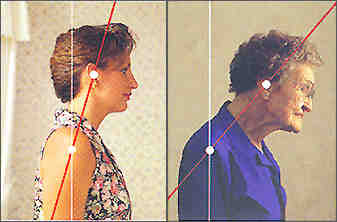|
|
Home Test
|
|
Headaches, back pain, numbness, tingling, and other health problems can often be traced to the spine.
Many things can cause the moving bones of the spine to lose their normal motion or position. This can irritate or choke the sensitive nerves that branch off the spinal cord to service the
organs and tissues of your body. Many spinal problems can cause postural changes.
Take a few moments to check a loved one.
Try these simple home tests. If you discover problems, encourage them to make an appointment with Dr. Michael Elrod for a complete spinal analysis. Spinal problems rarely get better on their own, and often get worse with time.
|
|
|
Test 1
Have adults or children being tested stand on a hard, flat surface. Have them close their eyes and "march in place" 2 or 3 steps and then stop.
With their eyes still closed, have them nod their head 2 or 3 times, as if they were looking at the floor and then the ceiling, stopping where they feel comfortable.
With their eyes still closed, examine their posture. From the front, all 9 test points should line up. If they are not in alignment, schedule a chiropractic examination today.
|

|
|
|
Still with their eyes closed, test their posture from the side. There are 4 points that should line up. Again, if these points are not in alignment, seek a thorough chiropractic examination.
|

|
|
|
Test 2
A low shoulder is a common postural deviation that may be an indication of a spinal malfunction with possible nervous system involvement.
|

|
|
|
Test 3
A common indicator of spinal stress is a head that is leaning too far forward. This puts wear and tear on the spine, leading to degenerative changes.
|

|
|
|
Test 4
Frequently, uneven shoe wear indicates some type of spinal imbalance. Examine a pair of shoes for unusual signs of wear.
|

|
|
|
Test 5
Often unequal pant leg length or an uneven skirt hemline can indicate a low hip or some other spinal problem.
|

|
|
|
Test 6
Have the adult or child being tested wear hard soled shoes and lie face down on a bed with their feet over the edge. Their legs should be kept together with their arms resting at each side.
During the test, the head must be facing straight down. This may be uncomfortable,
but should be maintained for the duration of the test.
|

|
|
|
Grasp both of the feet and apply equal pressure between the heel and the arch with your thumbs.
Check to see if one leg appears shorter.
|

|
|
|
Test 7
With the adult or child in the position as described in Test 6, test further by bending the legs up at the knees and compare again.
|

|
A contracted or short leg in either position is a common reaction to many types of spinal problems.
|

|
|
If any of these tests showed evidence of spinal problems, encourage them to make an appointment with Dr. Elrod at The Lewes Chiropractic Center by sending e-mail here Doc Elrod, I did the Home Test...
|
The information contained within these pages is meant only as a guideline for some of the treatments and services provided by Dr. Elrod and not as a substitute for doctor provided care. Before pursuing any self treatment for an ailment, you should first consult with your chiropractic physician, your primary care physician, or the nearest health care facility/hospital.Copyright © 2009 Lewes Chiropractic Center, All Rights
Reserved.For more information, click here DocElrod@LewesChiro.com
Return to Lewes Chiropractic Center's homepage www.LewesChiro.com
|









